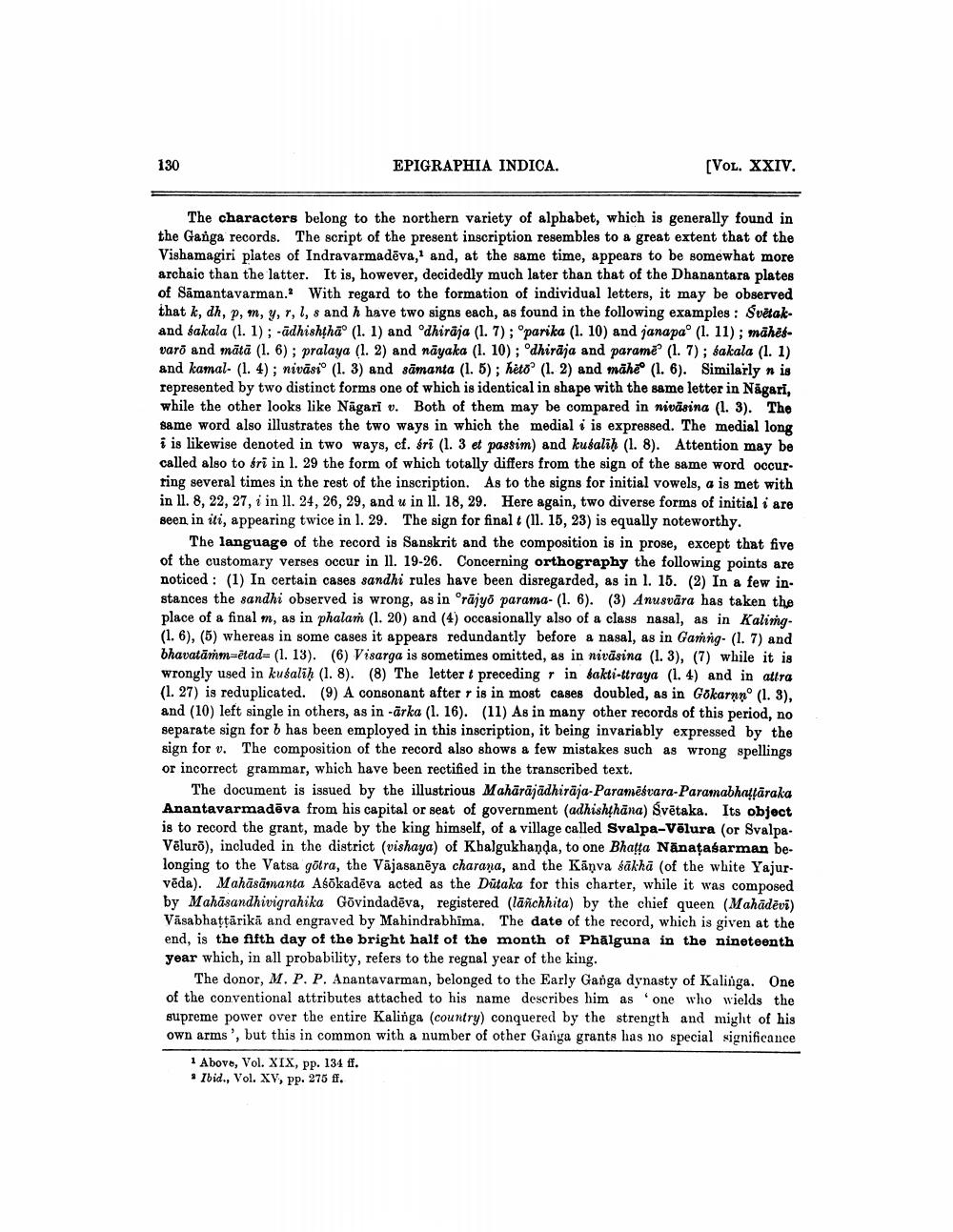________________
130
EPIGRAPHIA INDICA.
[VOL. XXIV.
The characters belong to the northern variety of alphabet, which is generally found in the Ganga records. The script of the present inscription resembles to a great extent that of the Vishamagiri plates of Indravarmadēva, and, at the same time, appears to be somewhat more archaic than the latter. It is, however, decidedly much later than that of the Dhanantara plates of Samantavarman. With regard to the formation of individual letters, it may be observed that k, dh, p, m, y, r, l, s and h have two signs each, as found in the following examples: Světakand sakala (1. 1); -adhishtha (1. 1) and °dhiraja (1. 7); parika (1. 10) and janapa° (1. 11); māhēśvarō and mātā (1. 6); pralaya (1. 2) and nayaka (1. 10); °dhiraja and parame (1. 7); sakala (1. 1) and kamal- (1. 4); nivāsi° (1. 3) and sāmanta (1. 5); heto (1. 2) and mahe (1. 6). Similarly n is represented by two distinct forms one of which is identical in shape with the same letter in Nagari, while the other looks like Nagari v. Both of them may be compared in nivasina (1. 3). The same word also illustrates the two ways in which the medial i is expressed. The medial long i is likewise denoted in two ways, cf. śri (1. 3 et passim) and kusaliḥ (1. 8). Attention may be called also to śri in 1. 29 the form of which totally differs from the sign of the same word occurring several times in the rest of the inscription. As to the signs for initial vowels, a is met with in 11. 8, 22, 27, i in 11. 24, 26, 29, and u in 11. 18, 29. Here again, two diverse forms of initial i are seen in iti, appearing twice in 1. 29. The sign for final t (11. 15, 23) is equally noteworthy.
The language of the record is Sanskrit and the composition is in prose, except that five of the customary verses occur in 11. 19-26. Concerning orthography the following points are noticed: (1) In certain cases sandhi rules have been disregarded, as in 1. 15. (2) In a few instances the sandhi observed is wrong, as in "rajyo parama- (1. 6). (3) Anusvära has taken the place of a final m, as in phalam (1. 20) and (4) occasionally also of a class nasal, as in Kalimg(1.6), (5) whereas in some cases it appears redundantly before a nasal, as in Gamng- (1.7) and bhavatāṁm=ētad= (1. 13). (6) Visarga is sometimes omitted, as in nivasina (1. 3), (7) while it is wrongly used in kusaliḥ (1. 8). (8) The letter t preceding r in sakti-ttraya (1.4) and in attra (1.27) is reduplicated. (9) A consonant after r is in most cases doubled, as in Gokarnṇ (1. 3), and (10) left single in others, as in -ärka (1. 16). (11) As in many other records of this period, no separate sign for b has been employed in this inscription, it being invariably expressed by the sign for v. The composition of the record also shows a few mistakes such as wrong spellings or incorrect grammar, which have been rectified in the transcribed text.
The document is issued by the illustrious Mahäräjädhiraja-Paramësvara-Paramabhaṭṭāraka Anantavarmadeva from his capital or seat of government (adhishthana) Svētaka. Its object is to record the grant, made by the king himself, of a village called Svalpa-Velura (or SvalpaVēluro), included in the district (vishaya) of Khalgukhanda, to one Bhatta Nanaṭasarman belonging to the Vatsa gōtra, the Vajasaneya charana, and the Kāņva śākkā (of the white Yajurvēda). Mahāsāmanta Asōkadēva acted as the Dutaka for this charter, while it was composed by Mahasandhivigrahika Govindadeva, registered (lañchhita) by the chief queen (Mahadevi) Vasabhaṭṭārikā and engraved by Mahindrabhima. The date of the record, which is given at the end, is the fifth day of the bright half of the month of Phalguna in the nineteenth year which, in all probability, refers to the regnal year of the king.
1 Above, Vol. XIX, pp. 134 #. Ibid., Vol. XV, pp. 275 ff.
The donor, M. P. P. Anantavarman, belonged to the Early Ganga dynasty of Kalinga. One of the conventional attributes attached to his name describes him as one who wields the supreme power over the entire Kalinga (country) conquered by the strength and might of his own arms', but this in common with a number of other Ganga grants has no special significance




